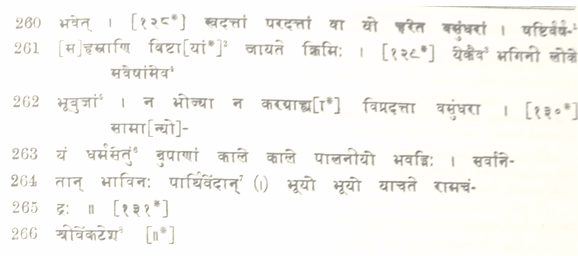|
The Indian Analyst
|
North Indian Inscriptions |
KUNIYUR PLATES OF VENKATA II.
TRANSLATION. (Line 1.) Obeisance to the blessed Veṅkaṭêśa ! ......(Verse 1.) I take refuge to that pair of objects which is to be worshipped by the gods, (and) at whose meritorious touch a stone became the best of women.9 ......(V. 2.) I take refuge to that Vishvaksêna whose more than hundred attendants, the elephant-headed (Gaṇêśa) etc., remove the obstacles (in the way) of (his) devotees.10
......(V. 3.) Victorious is the luminary (viz. the Moon) which rose from the milk-sea, (which is) the left eye of Hari (Vishṇu), (which is) the support of the chakôra (birds), (and) which sustains the life of the gods. ......(V. 4.) The grandson of him (viz. the Moon) (was) Budha’s son Purûravas ; his (son was) Âyus ; his was Nahusha ; from him was born Yayâti ; (and) from him Pûru. In his race was born king Bharata ; in his lingeage Śaṁtanu ; the fourth from him was Vijaya ; from him was born Abhimanyu ; (and) from him Parîkshit. ......(V. 5.) The eighth (in descent) from him was Nanda ; the ninth from this king was king Chaḷikka ; the seventh from him was Narêndra (whose name was) preceded by Râja (i.e. Râjanarêndra), (and) who was devoted to Śrîpati (Vishṇu) ; the tenth from him in this (world) was king Bijjaḷêndra ; (and) the third from him was Vîra-Hemmâḷirâya, the lord of Mâyâpurî, who prostrated himself before Murâri (Vishṇu). ......(V. 6.) The fourth from him was king Tâta-Pinnama, at whose sight the crowd of enemies
trembled ; from him was born that king Sômidêva who took from the enemy seven forts in a ......1 Read
| ||||||||||||||||||||||||||||||||||||||||||||||||||||||||||||||||||||||||||||
| > |
|
>
|








